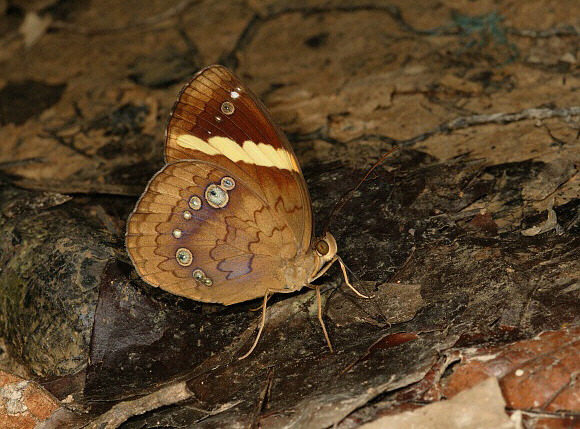
Introduction
This large forest-dwelling species was for many years considered to be a member of the former subfamily Amathusiinae. That subfamily no longer exists, taxonomists having decided to relegate it to the level of a tribe of the Morphinae ( now the Morphini, a tribe of the Satyrinae ). Eliot however was convinced that the butterfly was neither an Amathusiine or a Morphiine, pointing out that the larval stages had more in common with the traditional Satyrinae.
The uncertainties were finally cleared up in 2006, when Penz et al published a formal description of the immature stages which corroborated this view. They also provided evidence that the caterpillar possesses an ‘anal comb’ – a structure normally only found in the Hesperiidae and certain moth families, which is used to catapult the larval droppings away from the feeding site.
Research by Peňa & Wahlberg, released in 2008, using molecular evidence to trace the butterfly’s ancestry, implies that that the genus Xanthotaenia should be placed in the ‘primitive’ Satyrine tribe Zetherini, indicating that it is closely allied to Neorina, Penthema, Ethope and Callarge.
Xanthotaenia busiris is the only member of its genus. It is found in Myanmar, Thailand, Malaysia, Sumatra and Borneo.
Habitats
This species is found in primary rainforest, at elevations between about 100-300 metres.
Lifecycle
The caterpillar is smooth, green, and has head horns and a pair of caudal prongs. The foodplant is rattan palm Calamus ( Arecaceae ).
Adult behaviour
Both sexes seem to spend most of their lives skulking at ground level among the undergrowth, and are usually seen in the vicinity of stands of ginger ( Zingiberaceae ), often in company with the Amathusiine Faunis canens.
Xanthotaenia busiris is semi-crepuscular in behaviour, and is normally only active up until about mid-morning. It can however sometimes be disturbed later in the day – its presence being given away as it flies, by a flash of bright yellow from the bar across the upper forewings.
